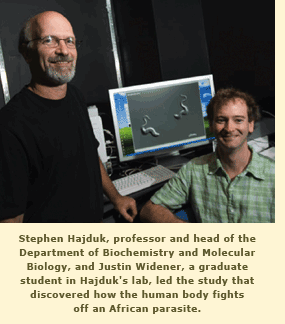One of the Human Body’s
Natural Defenses
A nasty class of single-celled parasites called trypanosoma usually causes serious, even fatal, diseases in humans and animals. Two species within this class result in sleeping sickness, for example, a disease that threatens all of sub-Saharan Africa. But a close relative of these parasites, called Trypanosoma brucei brucei (T. b. brucei), sickens animals while leaving humans seemingly unaffected, and scientists have never quite understood why—until recently.
 In research led by Stephen Hajduk, professor and head of UGA’s Department of Biochemistry and Molecular Biology, he and his colleagues posed a simple question: Why doesn’t T. b. brucei infect humans, even though it’s nearly identical to T. b. gambiense and T. b. rhodensiense, which respectively cause chronic and acute sleeping sickness in humans? Injected into the body by a bite of the tsetse fly, these parasites have been recognized by the scientific community as a major health issue since the first recorded outbreak of sleeping sickness in 1906.
In research led by Stephen Hajduk, professor and head of UGA’s Department of Biochemistry and Molecular Biology, he and his colleagues posed a simple question: Why doesn’t T. b. brucei infect humans, even though it’s nearly identical to T. b. gambiense and T. b. rhodensiense, which respectively cause chronic and acute sleeping sickness in humans? Injected into the body by a bite of the tsetse fly, these parasites have been recognized by the scientific community as a major health issue since the first recorded outbreak of sleeping sickness in 1906.
The Hajduk team concluded that T. b. brucei actually does infect humans, but also that the infection triggers the release of hemoglobin from red blood cells, which prevents the infection’s progress. Hemoglobin appears to “arm” the innate human immune system by binding to a small fraction of high-density lipoprotein (popularly known as “good cholesterol”). The hemoglobin-cholesterol complex then becomes a powerful toxin that clears the body of the trypanosome. The researchers’ results were published in Public Library of Science Pathogens in September 2007. Lead author was Justin Widener, a graduate student at Brown University who had been working in Hajduk’s lab before the professor moved to UGA in 2006. Other coauthors include April Shiflett of UGA and Marianne Jensby Nielsen and Søren Krag Moestrup of University of Aarhus in Denmark.
This research points to “a real paradigm shift in understanding what T. b. brucei does in humans,” said Hajduk. Because all three strains are closely related—T. rhodensiense differs from T. b. brucei by a single gene—what is true for one parasite species could be useful in studying the others. The defense mechanism triggered by T. b. brucei may ultimately help scientists develop improved ways of treating or preventing illnesses caused by parasites that do apparently affect humans.
For more information, contact Stephen Hajduk at: shajduk@bmb.uga.edu.
 |

